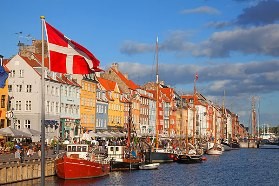First posted: 6 December 2011
Denmark is a mature (well-established) market* in the use of generic medicines. Generic medicines have been in use in Denmark since 1991 [1].
The current rules for substitution by pharmacists of generic for originator medicines in Denmark have contributed to Denmark having one of the largest markets for generic medicines in Europe [2]. In 2009 57% of prescriptions in Denmark were dispensed as generics, accounting for 23% of the market value [3].
In comparison with other Western European countries, Denmark is one of the countries spending somewhat more on health care as a whole, but relatively little on medicines. In 2008 Denmark spent 9.8% of its Gross Domestic Product (GDP) on health care, but only 7.3% of the total healthcare budget was spent on medicines [4, 5].
In 2007, Euros 2.5 billion was spent on medicines by Denmark, representing almost 10% more than in 2006 [6].
Investment in the pharmaceutical industry R & D in Denmark is one of the highest in Europe with Euros 150 per head of population being spent in 2002 [7].
The Danish generics market is relatively easy to enter, and Denmark has in principle free pricing for generic medicines, meaning that penetration of generic medicines is normally very successful. Entry shares for generic medicines within the first year are generally above 50% in terms of volume [8, 9].
Generics entry leads to large generics price decreases in Denmark. Average generics prices after just one year appear to be more than 50% below the price of the originator price prior to loss of exclusivity [9].
There are approximately 400 generic medicines approved by the Danish Medicines Agency (Lægemiddelstyrelsen, DKMA) [1] and sold in Denmark [10].
In Denmark, demand for generic medicines is driven by generics substitution by pharmacists [11].
Because pharmacists are obliged to dispense the cheapest variant of medicines, Denmark has some of the lowest generic medicine prices in Europe. Even when including expensive patented medicines, Danish medicine prices (exclusive of value added tax) are on average 7% lower than in other affluent EU countries. Prices on dispensed medicines have even fallen by 2.5% in 2007 and by 12% since 2003 [6].
The system of mandatory generics substitution seems to be very well accepted by patients. Nevertheless, patients have the option of refusing a generic drug without giving a reason [12].
Denmark has a rather fragmented pharmaceutical market and parallel imports in 2008 represented 16.5% in pharmacy market sales [8].
Key facts – contribution of generic medicines to Denmark
- In 2007, generic medicines saved the Danish society around Danish Kroner 6 billion [13]
- The generics industry supplies 69.7% of dispensed medicines at only 29.7% of the cost [11].
- Increased substitution of generics for the top 10 originator medicines could reduce public expenditure on the originator medicines in Denmark by 48% [14].
- The average cost of a generic medicine in Denmark is less than Euros 0.06 [6].
- In 2007, an average of Euros 177 per head of population was spent on medicines in Denmark compared with an average of Euros 382 in Western Europe [8, 15, 16].
- Denmark has some of the lowest generic medicine prices in Europe [6].
*A mature generics market is one where generics have been on the market for more than 10 years and where the market share of generics exceeds 40% [17].
References
1. Danish Medicines Agency (Lægemiddelstyrelsen, DKMA). Questions and answers about generic substitution [monograph on the Internet]. Copenhagen, Denmark, LIF [cited 2011 December 06]. Available from: www.dkma.dk/1024/visUKLSArtikel.asp?artikelID=7979
2. Danish Association of the Pharmaceutical Industry (Lægemiddel Industri Foreningen, LIF). 3.04 Subscription of drugs. Copenhagen, Denmark, DKMA [cited 2011 December 06]. Available from: www.lifdk.dk/sw24889.asp
3. Danish Medicines Agency (Lægemiddelstyrelsen, DKMA). Medicinal Product Statistics Denmark, 2005-2009 Total sales. June 2010.
4. Association of the Austrian Pharmaceutical Industry (Pharmig). Medicinal products and health care in Austria: Facts 2008/Edition 2010.
5. Nefarma, Feiten en cijfers [Dutch] [page on the Internet]. The Hague, The Netherlands, Nefarma [cited 2011 December 06]. Available from: www.nefarma.nl/feiten-en-cijfers
6. The Association of Danish Pharmacies (Danmarks Apotekerforening). Annual Report 2007-2008.
7. Van der Spiegel S. European Pharmaceutical Policy: Access for Patients or Improving Competitiveness. The European Commission’s Vision. OSE / RIZIV-INAMI, Brussels, 16 January 2006.
8. European Federation of Pharmaceutical Industries and Associations (EFPIA). The Pharmaceutical Industry in Figures. 2010.
9. Glowicka E, Lorincz S, Pesaresi E, Sauri Romero L, Verouden V. Generic entry in prescription medicines in the EU: Main characteristics, determinants and effects. July 8, 2009. Available from: www.ec.europa.eu/dgs/competition/economist/prescription_medicines.pdf
10. Industriforeningen for Generiske Lægemidler (IGL). Generic Medicine [monograph on the Internet]. Hellerup, Denmark, IGL [cited 2011 December 06]. Available from: www.igldk.dk/in-english/generic-medicine
11. Simoens S, De Coster S. Sustaining Generic Medicines Markets in Europe. April 2006. [monograph on the Internet]. Brussels, Belgium, European Generic medicines Association [cited 2011 December 06]. Available from: www.egagenerics.com/doc/simoens-report_2006-04.pdf
12. Vogler S, Schmikl B. Rational use of medicines in Europe. Österreichisches Bundesinstitut für Gesundheitswesen (ÖBIG). February 2010.
13. Industriforeningen for Generiske Lægemidler (IGL) [Danish] [homepage on the Internet]. Hellerup, Denmark, IGL [cited 2011 December 06]. Available from: www.igldk.dk/
14. Simoens S. Generic medicine pricing in Europe: current issues and future perspective. J Med Econ. 2008;11(1):171-5.
15. Plovsing J. Denmark in Figures 2008. Statistics Denmark. 2008.
16. ABPI. Did you know? Facts and figures about the pharmaceutical industry in the UK. [page on the Internet]. UK, ABPI [cited 2011 December 06]. Available from: www.abpi.org.uk/our-work/library/industry/Documents/Did%20you%20know_Jan11.pdf
17. Simoens S. International comparison of generic medicine prices. Curr Med Res Opin. 2007;23(11):2647-54.










